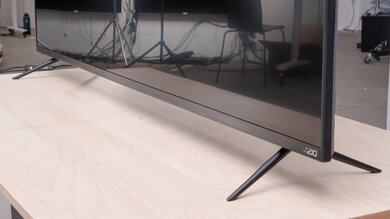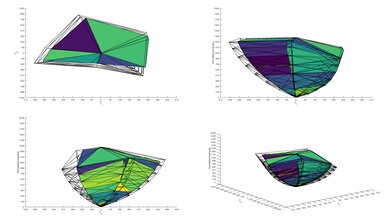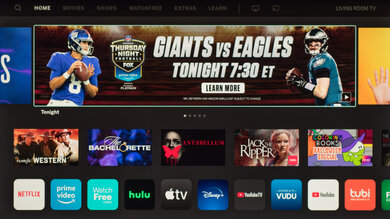The Vizio M8 Series Quantum 2020 is a good mid-range 4k TV. Like its predecessor, the Vizio M Series Quantum 2019, it sports a VA panel that can produce deep blacks for a great dark room viewing experience. It has an excellent HDR color gamut, allowing it to display rich and saturated colors in HDR content. Its response time is decent, input lag is low, and it supports variable refresh rate technology to reduce screen tearing when gaming. It handles reflections decently well and gets bright enough to overcome glare, but not quite bright enough to make highlights stand out in HDR content. Its VA panel's viewing angles are quite narrow, so it isn't the best option for large seating areas, as the image looks inaccurate when viewed from the side. Lastly, while it has a full-array local dimming feature, its sub-par implementation results in a lot of blooming around bright objects.
At the time of writing, this TV is difficult to find through most major retailers. We'll provide links once they're available. Our unit was purchased from Walmart.
Our Verdict
The Vizio M Series Quantum 2020 is a good TV overall. Like most VA panel TVs, it delivers deep blacks, making it a great choice to watch movies or play video games in the dark. It has a decent response time and low input lag, and it can display proper chroma 4:4:4 when using it as a PC monitor. It overcomes glare easily in a well-lit environment but doesn't get bright enough to deliver a satisfying HDR experience. Also, its poor viewing angles make it less suitable for large rooms or wide seating areas.
- High contrast ratio.
- Decent response time.
- Gets bright enough to fight glare.
- Poor viewing angles.
- Dirty screen effect.
The Vizio M Series Quantum is great for watching movies. Its high contrast ratio allows it to produce deep blacks, great for watching movies in the dark. It upscales 1080p content well and can remove judder from low frame rate content. It has a full-array local dimming feature; however, it doesn't perform well, as it causes a lot of blooming around bright objects.
- High contrast ratio.
- Decent black uniformity.
- Doesn't stutter much in low frame rate content.
- Sub-par local dimming.
- Dirty screen effect.
The Vizio M Series Quantum is decent for watching TV shows. It provides good visibility in well-lit environments, as it gets bright enough to fight glare and has decent reflection handling. Its VA panel has poor viewing angles, so it isn't ideal if you like walking around while watching TV. Vizio's SmartCast platform is easy to use, but its app selection is limited because there's no app store. You can safely leave it on the same channel or programming all day since its VA panel is immune to permanent burn-in.
- Decent reflection handling.
- Gets bright enough to fight glare.
- Poor viewing angles.
- Dirty screen effect.
The Vizio M Series Quantum is decent for watching sports. It has a decent response time and a Black Frame Insertion feature to deliver fast-moving scenes with minimal motion blur. It handles reflections decently well and gets bright enough to overcome glare. Unfortunately, its VA panel's narrow viewing angles might be an issue, especially if you like watching with a big group of people. There's a fair amount of dirty screen effect on our unit; however, this can vary between individual units.
- Decent response time.
- Decent reflection handling.
- Gets bright enough to fight glare.
- Poor viewing angles.
- Dirty screen effect.
The Vizio M Series Quantum is great for gaming. Its decent response time results in only a short blur trail behind fast-moving objects, and it has an optional Black Frame Insertion feature to improve motion clarity. It has incredibly low input lag, providing a responsive gaming experience. It's well-suited for dark room gaming, as it has a high contrast ratio and exceptional black uniformity. The refresh rate is limited to 60Hz, but on the bright side, it supports variable refresh rate technology to reduce screen tearing.
- Low input lag.
- Decent response time.
- Variable refresh rate.
- Dirty screen effect.
The Vizio M Series Quantum is good for watching movies in HDR. It has a high contrast ratio and exceptional black uniformity, making it an excellent choice for dark rooms. It can produce rich and vibrant colors due to its excellent color gamut, but it doesn't get bright enough to make highlights stand out in HDR content. Also, the local dimming causes a lot of blooming around bright objects and can be distracting.
- High contrast ratio.
- Excellent HDR color gamut.
- Decent black uniformity.
- Doesn't stutter much in low frame rate content.
- Mediocre HDR peak brightness.
- Sub-par local dimming.
- Dirty screen effect.
The Vizio M Series Quantum is great for gaming in HDR. It has a decent response time and low input lag, and it supports variable refresh rate technology to minimize screen tearing. It performs remarkably well in dark rooms thanks to its high contrast ratio and exceptional black uniformity. Its excellent color gamut allows it to produce a wide range of colors in HDR content, but sadly, it doesn't get bright enough to make highlights pop.
- High contrast ratio.
- Low input lag.
- Decent response time.
- Excellent HDR color gamut.
- Variable refresh rate.
- Mediocre HDR peak brightness.
- Sub-par local dimming.
- Dirty screen effect.
The Vizio M Series Quantum is a good TV for use as a PC monitor. It has low input lag and a decent response time to make the desktop experience feel smooth and responsive. It supports most common resolutions and can display chroma 4:4:4 for optimal text clarity. Unfortunately, it has poor viewing angles, so the edges of the screen can look washed out if you sit too close. On the upside, you don't have to worry about permanent burn-in, as its VA panel is immune to it.
- Low input lag.
- Decent response time.
- Decent reflection handling.
- Poor viewing angles.
- Dirty screen effect.
Changelog
- Updated Oct 20, 2021: We updated the 'Voice Control' results to be more consistent with our other reviews.
- Updated Aug 02, 2021: Added the real content local dimming videos.
- Updated Mar 01, 2021: Converted to Test Bench 1.6.
- Updated Jan 13, 2021: We've retested the local dimming to check on the flashing issue in Dolby Vision content.
Check Price
Differences Between Sizes And Variants
We reviewed the 65" Vizio M Series Quantum 2020 (M65Q8-H1), and we expect our results to be valid for the 55" (M55Q8-H1) model as well. There's an M7 variant of this TV, which has a few differences, such as the number of local dimming zones. There's a Black Friday model that's only available at a 70" size, which has slightly reduced features, such as having three HDMI ports instead of four. It likely has a different number of local dimming zones; however, we aren't able to confirm it. If you come across this model, please let us know in the discussions below.
| Size | Model | Black Friday Model | Dimming Zones |
|---|---|---|---|
| 55" | M55Q8-H1 | 90 | |
| 65" | M65Q8-H1 | 90 | |
| 70" | M706x-H3 | Unknown |
If someone comes across a different type of panel or if their M Series 2020 doesn't correspond to our review, let us know, and we will update the review. Note that some tests, such as gray uniformity, may vary between individual units.
You can see the label here.
Popular TV Comparisons
The Vizio M Series 2020 is a good TV for most uses. However, there are better TVs in the same price range, like the Hisense H8G. The Hisense has a much better local dimming feature and more apps through the Google Play Store. For more options, check out our recommendations for the best TVs, the best 4k TVs, and the best 4k gaming TVs.
The TCL R635 is a bit better than the Vizio M8 Series Quantum 2020. The TCL gets a lot brighter, it has faster response time, and it can remove judder from all sources. On the other hand, the Vizio has better color accuracy and lower input lag.
The Vizio M8 Series Quantum 2020 and the Hisense H8G are very similar TVs overall, with only a couple of differences. The Vizio has a higher contrast ratio, better color gamut, and variable refresh rate support. On the other hand, the Hisense has a better local dimming feature, faster response time, and it gets brighter.
For most uses, the Vizio M8 Series Quantum 2020 is much better than the Sony X750H. The Vizio has full-array local dimming, higher peak brightness, and a significantly better HDR color gamut. It also has better color accuracy, a Black Frame Insertion feature, and variable refresh rate support. The Sony's backlight is completely flicker-free, and its Android TV platform gives access to more apps through the Google Play Store.
The Vizio M8 Series Quantum 2020 is much better than the Samsung TU8000. The Vizio has a full-array local dimming feature, significantly better color gamut and gradient handling, and gets a lot brighter in SDR and HDR. The Samsung has better black uniformity, and it can interpolate lower frame rate content.

We buy and test dozens of TVs yearly, taking an objective, data-driven approach to deliver results you can trust. Our testing process is complex, with hundreds of individual tests that take over a week to complete. Most of our tests are done with specially designed test patterns that mimic real content, but we also use the same sources you have at home to ensure our results match the real-world experience. We use two main tools for our testing: a Colorimetry Research CR-100 colorimeter and a CR-250 spectroradiometer.
Test Results

The Vizio M Series Quantum 2020 has an excellent design. It's nearly, if not entirely, identical to the Vizio M Series Quantum 2019. It's simple and minimalist, with thin borders on all sides and wide-set feet.
The top portion of the back is metal, while the bottom portion is made out of plastic. Some of the inputs are bottom-facing, but they're easy to access even when the TV is wall-mounted. Unfortunately, there's no cable management.
The Vizio M Series Quantum has an excellent contrast ratio, and it gets a lot better with local dimming enabled. Blacks look deep and inky, which is great for watching in a dark environment. Note that the contrast ratio can vary between units.
The Vizio M Series Quantum 2021 has good SDR peak brightness. It varies a lot depending on the scene, but overall, it's enough to overcome glare in bright lighting conditions.
We measured the SDR peak brightness after calibration, using the 'Calibrated Dark' Picture Mode, with Active Full-Array set to 'High', Color Temperature set to 'Warm', and Gamma set to '2.2'.
If you don't mind a slightly less accurate image, you can achieve a higher peak brightness by setting the Picture Mode to 'Vivid, Active Full-Array to 'High', and Color Temperature to 'Cool'. We achieved a peak brightness of 648 cd/m² in the 10% window using these settings.
Update 08/02/2021: Added the real content local dimming videos.
Update 01/13/2021: We've retested the local dimming, specifically the flashing issue in Dolby Vision content. It seems like there's some improvement as the flashing isn't as noticeable, but it's still present. We also encountered a bug that causes red and green flashes in the opening scene of 'Our Planet'.
Update 12/22/2020: We've retested the local dimming with the latest firmware version 1.10.15.1-2. Not much has changed except that we now recommend using the 'Medium' setting instead of 'High'. The 'Medium' setting isn't as aggressive as the 'High' and causes less blooming.
The Vizio M Series Quantum has a sub-par local dimming feature. There are a few issues with its implementation, as well as some bugs that need fixing through a firmware update. The recommended setting is 'Medium' (local dimming is called Active Full-Array in the settings menu) and is the setting we used for testing.
The most glaring issue with the local dimming is the amount of blooming. There's a lot of it, and like the Vizio P Series Quantum 2020, it's inconsistent between different areas of the screen, which makes the screen look blotchy and accentuates uniformity issues. In dark scenes with small highlights, like a starfield, it has a hard time deciding which stars should stand out, so while some stars look bright with blooming around, others look dim. Subtitles aren't handled well, and there's a lot of blooming around them.
It doesn't crush blacks, although it's mostly due to the higher overall black level and the amount of blooming present. Zone transitions are very slow, and the lighting zones are visible when bright objects move across the screen.
We encountered a few bugs with the local dimming. The first is that the TV indicates that the local dimming is on even when it's off. Turning the local dimming off and back on again usually resolves this issue. The second bug is that the local dimming shuts off when viewing Dolby Vision content. Unfortunately, there's no workaround for this, and it requires a firmware update. We'll retest it once it's available. The third bug is that when the TV is in 'Dolby Vision Bright' Picture Mode and local dimming is set to 'Medium', the screen flickers when it displays a bright, static image, even though the local dimming is disabled due to the mentioned bug.
Update 08/02/2021: Added the real content local dimming videos.
The Vizio M Series Quantum's HDR peak brightness is mediocre. It's an improvement over the Vizio M Series Quantum 2019, but it still isn't enough to make highlights pop in HDR content. Just like in SDR, the brightness varies a lot across different content.
We measured the HDR peak brightness before calibration, using the 'Calibrated Dark' Picture Mode, with Active Full-Array set to 'High', Color Temperature set to 'Warm', and Gamma set to '2.2'.
If you want an even brighter picture and don't mind losing image accuracy, set the Picture Mode to 'Vivid', Active Full-Array to 'High', Color Temperature to 'Cool', and Gamma to '1.8'. We achieved a peak brightness of 629 cd/m² in the 10% window using the settings.
Update 10/26/2020: We've reuploaded a new gray uniformity picture and updated the score from 6.5 to 6.7.
Gray uniformity on our unit of the Vizio M Series Quantum is okay. There's noticeable dirty screen effect in the center, and there are a few spots that appear darker than the rest of the screen, like the top corners. It's much better in dark scenes, but the dirty screen effect is still visible. Note that gray uniformity can vary between units.
Update 10/26/2020: We've reuploaded a new black uniformity picture and updated the score from 9.1 to 9.3.
Black uniformity on our Vizio M8 Series Quantum is exceptional. With local dimming disabled, the whole screen looks more grayish but otherwise very uniform. With local dimming enabled, black level is much better, but the blooming around the test cross is more visible. Note that black uniformity can vary between units.
The Vizio M Series Quantum has decent reflection handling. It handles ambient light well but struggles more with direct reflections, so it's best to avoid placing the TV opposite bright lights.
The Vizio M65Q8-H1's out-of-the-box color accuracy is decent. Most colors are only slightly inaccurate and are hard to spot. White balance is off, and the color temperature is much warmer than our 6500K target, resulting in a slight reddish tint. Gamma follows the target reasonably well, although most scenes are too dark and bright scenes are too bright. Note that color accuracy can vary between units.
After calibration, the Vizio M Series Quantum's color accuracy is exceptional. White balance and gamma are nearly perfect, and the color temperature is much closer to our 6500K target. The remaining color inaccuracies shouldn't be noticeable without the aid of a colorimeter.
You can see our recommended settings here.
The Vizio M Series Quantum uses a BGR sub-pixel structure. It doesn't affect picture quality but can affect text clarity when using the TV as a PC monitor. You can read more about it here.
Excellent HDR color gamut. The Vizio M65Q8-H1 has near full coverage of the commonly-used DCI P3 color space and great coverage of the wider Rec. 2020. The EOTF follows the PQ curve reasonably well until the roll-off, but most scenes are too dark. The 'Game' Mode EOTF follows the target curve much closer; however, dark scenes are still too dark, and the roll-off is more abrupt.
If you find HDR content too dim, you can make it brighter by setting the Picture Mode to 'Calibrated Dark', Active Full-Array to 'High', Color Temperature to 'Normal', and Local Contrast to 'High'. These settings result in a brighter image, as you can see in this EOTF.
Great color volume. It displays dark and saturated colors well thanks to its high contrast ratio. It struggles with bright blues, which is typical for LCDs.
The Vizio M Series Quantum has great gradient handling. There's only some fine banding in the darker shades. There's no setting to help smooth it out, and enabling Noise Reduction doesn't seem to help at all.
The Vizio M Series Quantum doesn't exhibit any signs of temporary image retention after exposing a high-contrast image for ten minutes. However, this can vary between individual units.
We don't expect VA panels to experience permanent image retention, as the VA panel in our long-term test appears immune.
The Vizio M65Q8-H1 has an optional Black Frame Insertion feature to help improve motion clarity. When enabled, the backlight's flickering frequency drops to 60Hz. Unfortunately, it causes a bit of image duplication with 60fps content. To turn on BFI, enable Clear Action.
The Vizio M65Q8-H1 doesn't have a motion interpolation feature.
Due to the TV's slower response time, there's no stutter in 60fps content. However, it can stutter a bit in 24p content.
The Vizio M Series 2020 can remove judder from 24p sources and native apps, but not from 60i/60p sources. To remove judder, enable Film Mode.
Update 10/26/2020: We've retested the VRR with the new firmware (version 5.10.13.1-2). It now works at all supported resolutions.
The Vizio M Series 2020 is advertised to support HDMI Forum VRR to help reduce screen tearing when gaming. We can confirm that it works with FreeSync, but we aren't certain that HDMI Forum VRR works because the Xbox One that we use for testing supports both, and there's no way to tell which one is active. To turn on VRR, enable Variable Refresh Rate.
Update 10/26/2020: We've retested the input lag with the latest firmware (version 5.10.13.1-2). Unfortunately, we're still unable to measure the input lag at 1440p with VRR, as VRR doesn't work properly when performing our input lag test, even though it works properly during our VRR test. Also, 1440p seems to only work with our laptop. Using an Xbox One, we had to force 1440p, and VRR isn't available when using a forced resolution.
The Vizio M Series Quantum has outstanding low input lag. It's higher when displaying a 1440p @ 60Hz signal, although it's likely a bug that'll be fixed in a future firmware update. To get the lowest input lag, set Game Low Latency to 'On'. Setting it to 'Auto' enables the 'Auto Low Latency Mode', which is a feature that automatically turns on the low latency mode when it detects a game launching from a compatible device.
When using the TV as a PC monitor with chroma subsampling, set the PC to RGB (see supported resolution section) and Game Low Latency to 'On' to get the lowest input lag.
Update 12/22/2020: We've updated the firmware to version 1.10.15.1-2 and retested the TV's ability to display a 10-bit 4k @60Hz signal with chroma 4:4:4. The maximum signal that it can display at 10-bit is with chroma 4:2:0.
The Vizio M Series Quantum supports most resolutions at 60Hz. It can display proper chroma 4:4:4; however, it's a little buggy right now. To display chroma 4:4:4 properly, you have to set both the PC and the TV to 'RGB' (setting the PC to RGB grays out the Full Color 444 option on the TV). This is because the Full Color 444 option looks bad and causes text to look more blurry, and setting the PC to chroma 4:4:4 makes it even worse. It's likely a bug that'll be fixed in a future firmware update. Vizio has removed the 'Computer' mode.
For signals that require full bandwidth, the Full UHD Color setting has been removed, so there's nothing to change.
Update 12/22/2020: We've retested the HDMI ports with the latest firmware version 1.10.15.1-2 and an HDMI 2.1 source. All ports are functioning as HDMI 2.0 even though they're advertised as HDMI 2.1.
Update 10/26/2020: We've retested all the ports for HDMI 2.1 support using an NVIDIA RTX 3080 graphics card. They're all limited to 4k @ 60Hz only, which is to be expected as this TV only has a 60Hz panel.
The Vizio M Series Quantum is advertised to have HDMI 2.1 ports. However, unlike the Vizio P Series Quantum 2020, it isn't indicated which ports have proper support. At this time, they're limited to HDMI 2.0's bandwidth.
The Vizio M Series Quantum supports eARC, allowing the TV to send high-quality object-based audio like Dolby Atmos via TrueHD over an HDMI connection. To use it, set eARC to 'On' and Digital Audio Output to 'Auto'.
The Vizio MQ8's frequency response is mediocre. It delivers dialogue clearly, but there's a noticeable lack of bass. Unfortunately, it doesn't get very loud, so it isn't ideal for noisy environments. There isn't much compression when playing at max volume, though, which is great.
Note: We received reports of audio issues with the Vizio M7 Series Quantum 2020 and the Vizio M8 Series Quantum 2020. Audio seems to cut out during quiet scenes or when there's a pause in sound, such as when scrolling through menus. It also can also make a popping or crackling sound in these situations, as you can see in this video posted on Reddit. It seems to be a problem with the internal speakers, but we've read reports of it continuing with a soundbar as well. We didn't notice this during testing, but if you've experienced the same issue, let us know.
The distortion performance is just okay. It sounds pretty clean when playing at moderate volume levels, but there's a fair amount of distortion when playing at max volume. That said, it depends on the content and might not be audible for some.
Vizio's SmartCast platform is decent. It's user-friendly and runs smoothly for the most part. Other than the bugs mentioned in the local dimming section, we didn't experience any other issues.
There's suggested content on the home page, and it isn't possible to disable it. Thankfully, there aren't any ads.
Update 10/20/2021: We updated the 'Voice Control' results for consistency with our other reviews. The M8 Series Quantum 2020 doesn't have voice control on the remote, but you can use voice commands through the companion app on your phone.
The remote control has changed slightly compared to the Vizio M Series Quantum 2019's. It now has a circular navigation pad and a dedicated button for Vizio's 'Watch Free' feature. There's no built-in microphone for voice control, but you can control a few basic functions, including changing inputs or launching apps, from the companion app on your phone.

















































